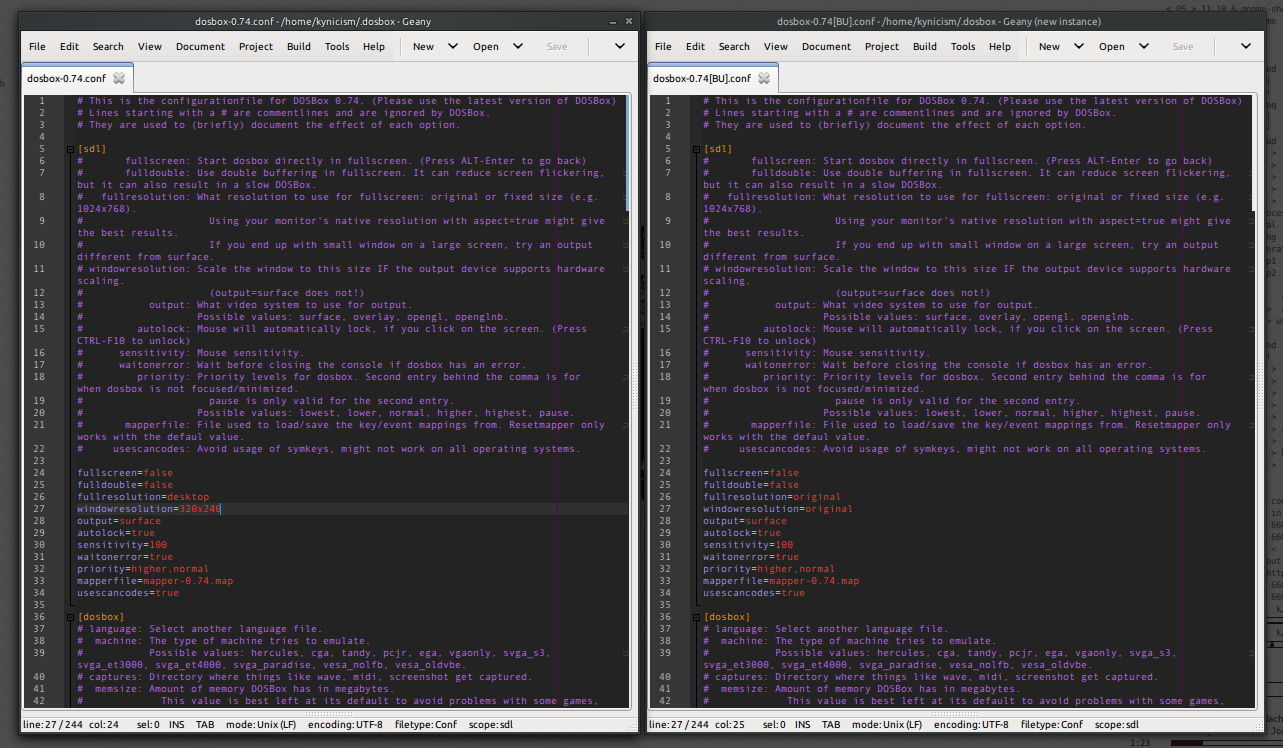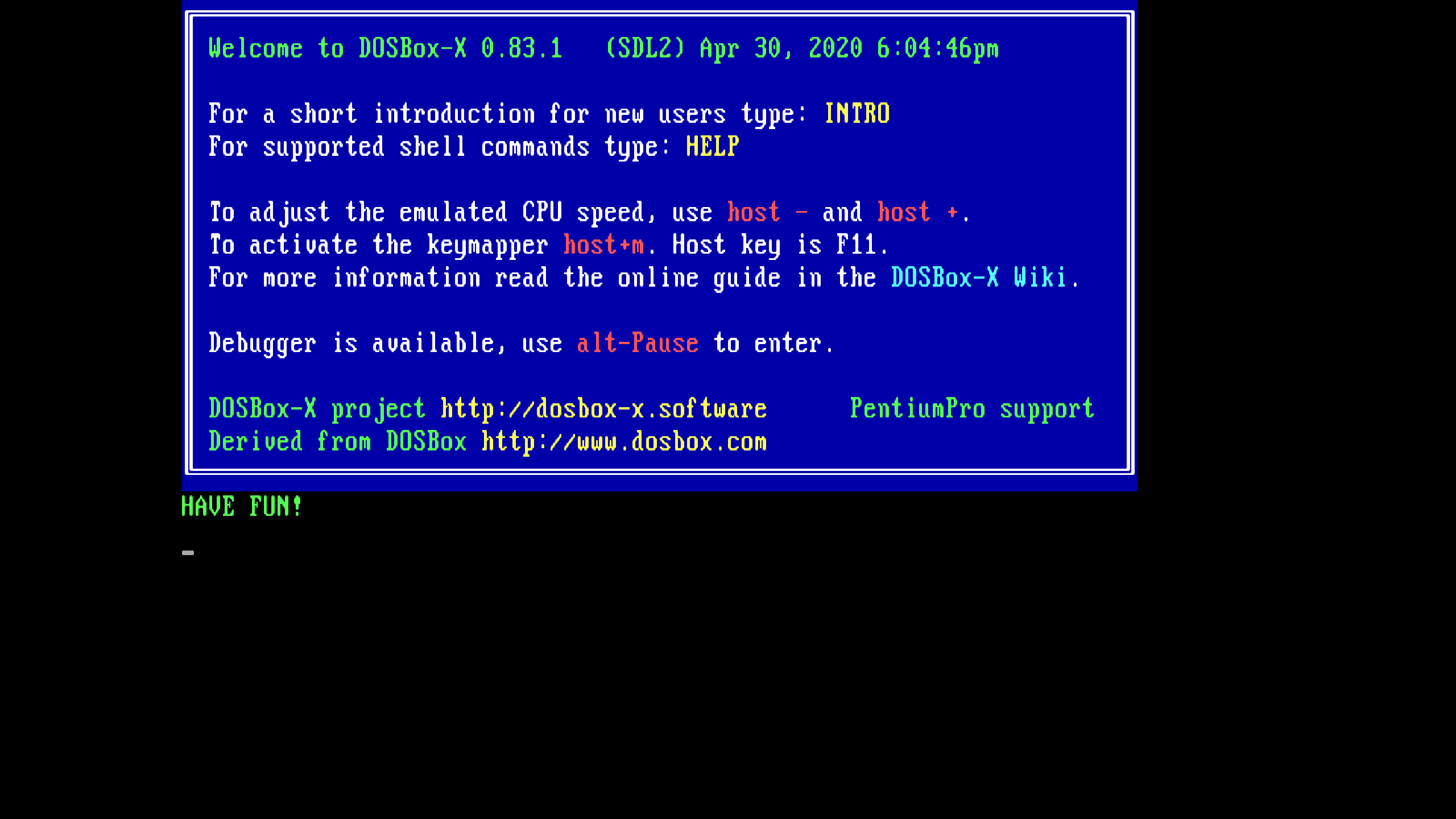

- #Dosbox output movie
- #Dosbox output install
- #Dosbox output manual
- #Dosbox output mac
- #Dosbox output windows

opencaptures program calls program with as first paramater the location of the captures folder. You can specify this command more than once. editconf program calls program with as first parameter the configuration file. version Output version information and exit. The machinetype has influence on both the videocard and the available soundcards. Svga_et4000, svga_paradise, vesa_nolfb, vesa_oldvbe. Valid choices are: hercules, cga, tandy, pcjr, ega, vgaonly, svga_s3(default), svga_et3000, machine machinetype Setup dosbox to emulate a specific type of machine. exit dosbox will close itself when the DOS program specified by file ends. lang langfile Start dosbox with the language specified in langfile. Multiple configfiles can be present at the commandline. This file has a section in which you can put commands you wish to execute on startup. conf configfile Start dosbox with the options specified in configfile.

AĬommand can be: an Internal Program, a DOS command or an executable on a mounted drive. Each command should start with -c though. c command Runs the specified command before running file. forcescaler scaler Similar to the -scaler parameter, but tries to force usage of the specified scaler even if it might not fit. See the configuration file for the available scalers scaler scaler Uses the graphical scaler specified by scaler. userconf Load the configuration file located in ~/.dosbox. securemode Same as -noautoexec, but adds -securemode at the end of AUTOEXEC.BAT (which in turn disables any changes to how the drives noautoexec Skips the section of the loaded configuration file. You can use it to change the keys dosbox uses. startmapper Start the internal keymapper on startup of dosbox. fullscreen Start dosbox in fullscreen mode. If it is a directory, a DOS session will run with the directory mounted as C:\.įor an introduction type INTRO inside dosbox. The optional file argument should be a DOS executable or a directory.
#Dosbox output manual
This manual page briefly documents dosbox, an x86/DOS emulator.
#Dosbox output mac
Mac users can use Perian to view the captured video in QuickTime Player.Dosbox MPlayer (a popular command line video player) should be able to play the captured video without any special configuration.
#Dosbox output movie
If you are still experiencing difficulty playing your captured movie you can try alternative media players like VideoLAN or Media Player Classic Linux
#Dosbox output install
You might notice that your computer is performing some actions in the background but there will be no actual confirmation that this install was successful (other than trying to play your movie). If you installed the Start Menu shortcuts simply select Install movie codec
#Dosbox output windows
The Win 32 Release of DOSBox includes the necessary CODEC and install scripts needed to allow Windows Media Player (or almost any other movie player in Windows) to playback the recorded files. The video portion of the movie is encoded with the 32bit ZMBV (Zip Motion Block Video) CODEC, which allows for reasonably fast encoding of low color content. Most computers may look like they are already configured to play the captures movie, but most likely they are not. Like screenshots, any filters will not be recorded or affect the content of the captured video.Įach platform is different so you may need to search around for specific help. If the current application is changed while a movie is being recorded the filename will not change, but if the video mode changes then the current recording will automatically be stopped and a new movie in the new resolution will be created with the name of the last executed application. The video mode currently being emulated will determine the resolution of the captured video, and the currently running game or application will determine the name of the captured file. An alternative that may work by default is adding to the keystrokes, for a combination of CTRL-SHIFT-ALT-F5 (tested with KDE on openSUSE 13.1) You'll have to go to the keymapper and change the key combination used for "Video". Note: Under Linux, most Window Managers will use this key combination to go to the 5th console terminal screen. To stop/end the recording, you have to press CTRL-ALT-F5 again. To record a movie, you have to press CTRL-ALT-F5. Starting with version 0.65, DOSBox allows you to create movies out of screen output.


 0 kommentar(er)
0 kommentar(er)
